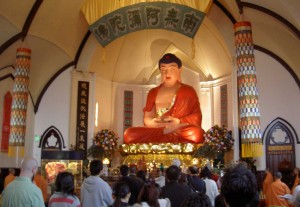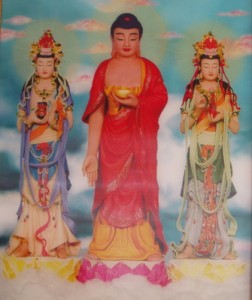
The Chinese characters (read from right to left on banner hung over statue) translate as Na-mo O’mi-tuo Fo, the hymn of praise sung to Amitaba Buddha.

Amitabha Buddha with His two attendant bodhisattvas–Avalokitesvara on the right and Mahasthamaprapta on the left.
A disciple of Dorje Chang Buddha, Amitabha Buddha (O’mi-tuo Fo) is the Buddha of the West, representing discriminating wisdom.
Pure Land Buddhism, the dominant form of Buddhist practice in China, Japan, Korea, Taiwan, and Vietnam, teaches that through devotion to Amitabha, one will be reborn in the Pure Land or the Western Paradise or Land of Bliss (Sukhavati) in which enlightenment is guaranteed. Amitabha is often seen with His two attendant Bodhisattvas: Avalokitesvara, representing engaged compassion, and Mahasthamaprapta, representing wisdom. Avalokitesvara means “Regarder of the Cries of the World,” while Mahasthamaprapta means “The One Who Has Attained Great Strength.”
